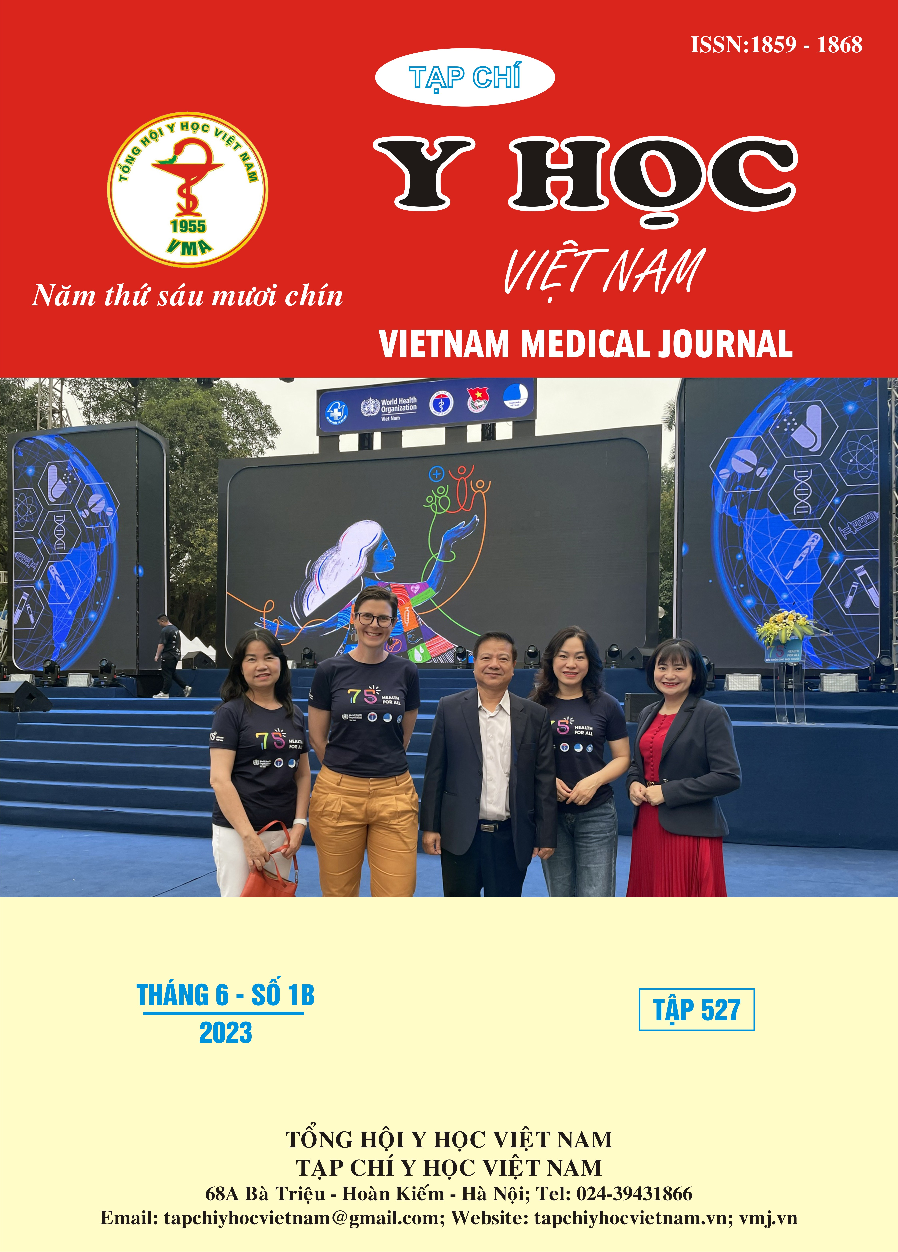OBSTRUCTIVE SLEEP APNEA IN OUTPATIENTS AT CAN THO UNIVERSITY OF MEDICINE AND PHARMACY HOSPITAL – AN OBSERVATIONAL STUDY
Main Article Content
Abstract
Background: Obstructive sleep apnea (OSA) is a condition characterized by repeated pauses in breathing during sleep, frequently accompanied by snoring, daytime sleepiness, and is diagnosed using polysomnography or respiratory polygraphy with an apnea-hypopnea index greater than 5/hour. Objective: (1) To evaluate some biometric characteristics, scores comorbidities on OSA outpatients at the Respiratory Units of Can Tho University of Medicine and Pharmacy Hospital; (2) To survey on respiratory symptom severity, airway obstruction and aerosol treatment characteristics in patients with OSA and COPD; (3) To determine the correlations between the severity of OSA and specific patient characteristics. Methods: cross-sectional, single-center descriptive study. We enrolled 48 outpatients with symptoms as snore, or daytime sleepiness at the RU-CTUMP in the study in three months. Results: 48 patients were divided into two groups with overlapped COPD and risk of OSA (COSA, n = 30) vs. risk of OSA-only (ROSA, n = 18). Overlapped patients had more comorbidities than ROSA patients (Charlson scores of 2.33 and 1.17, respectively). In the COSA group, 100% of the patients suffered from dyspnea with the mean mMRC scores of 2.83 ± 0.75, mean FEV1 was 60.07 ± 23.09%, and 86% received inhaled medicine. There were significant correlations between the AHI value and the body mass index, neck circumferences, STOP-Bang score, the value of the Snoring Severity Scale, and minimum SpO2 (r = 0.45, 0.43, 0.46, 0.44, -0.69, respectively). In addition, COPD was a risk factor for OSA (OR = 1.125). Conclusions: OSA is a condition that should be screened for in patients with COPD. Clinicians can use several predictors of obstructive sleep apnea, including BMI, neck circumference, STOP-Bang questionnaire, SSS snoring score to prognosis OSA.
Article Details
Keywords
Chronic Obstructive Pulmonary Disease; Obstructive Sleep Apnea; Respiratory Polygraphy; AHI.
References
2. Choi K-M, Thomas RJ, Kim J, Lee SK, Yoon DW, Shin C. Overlap syndrome of COPD and OSA in Koreans. Medicine (2017) 96:e7241. doi: 10.1097/MD.0000000000007241
3. Kapur VK, Auckley DH, Chowdhuri S, Kuhlmann DC, Mehra R, Ramar K, Harrod CG. Clinical Practice Guideline for Diagnostic Testing for Adult Obstructive Sleep Apnea: An American Academy of Sleep Medicine Clinical Practice Guideline. Journal of Clinical Sleep Medicine (2017) 13:479–504. doi: 10.5664/ jcsm.6506
4. Lacedonia D, Carpagnano GE, Patricelli G, Carone M, Gallo C, Caccavo I, Sabato R, Depalo A, Aliani M, Capozzolo A, et al. Prevalence of comorbidities in patients with obstructive sleep apnea syndrome, overlap syndrome and obesity hypoventilation syndrome. Clin Respir J (2018) 12:1905–1911. doi: 10.1111/crj.12754
5. Oshita H, Ito N, Senoo M, Funaishi K, Mitama Y, Okusaki K. The STOP-Bang Test Is Useful for Predicting the Severity of Obstructive Sleep Apnea. JMA J (2020) 3:347–352. doi: 10.31662/jmaj.2020-0002
6. Shawon MSR, Perret JL, Senaratna C v., Lodge C, Hamilton GS, Dharmage SC. Current evidence on prevalence and clinical outcomes of co-morbid obstructive sleep apnea and chronic obstructive pulmonary disease: A systematic review. Sleep Med Rev (2017) 32:58–68. doi: 10.1016/j.smrv.2016.02.007
7. Tom C, Roy B, Vig R, Kang DW, Aysola RS, Woo MA, Harper RM, Kumar R. Correlations Between Waist and Neck Circumferences and Obstructive Sleep Apnea Characteristics. Sleep Vigil (2018) 2:111–118. doi: 10.1007/s41782-018-0041-1
8. Venkateswaran S, Tee A. Overlap syndrome between chronic obstructive pulmonary disease and obstructive sleep apnoea in a Southeast Asian teaching hospital. Singapore Med J (2014) 55:488–492. doi: 10.11622/smedj.2014117.
1. Lê Xuân Vựng, Ngô Quý Châu, Vũ Văn Giáp. Một số yếu tố nguy cơ mắc hội chứng ngừng thở tắc nghẽn khi ngủ ở bệnh nhân bệnh phổi tắc nghẽn mạn tính nhập viện tại trung tâm hô hấp – Bệnh viện Bạch Mai. Tạp chí Y học Việt Nam (2022) 519:275–8. https://tapchiyhocvietnam.vn/index.php/vmj/article/download/3667/3368
2. Choi K-M, Thomas RJ, Kim J, Lee SK, Yoon DW, Shin C. Overlap syndrome of COPD and OSA in Koreans. Medicine (2017) 96:e7241. doi: 10.1097/MD.0000000000007241
3. Kapur VK, Auckley DH, Chowdhuri S, Kuhlmann DC, Mehra R, Ramar K, Harrod CG. Clinical Practice Guideline for Diagnostic Testing for Adult Obstructive Sleep Apnea: An American Academy of Sleep Medicine Clinical Practice Guideline. Journal of Clinical Sleep Medicine (2017) 13:479–504. doi: 10.5664/ jcsm.6506
4. Lacedonia D, Carpagnano GE, Patricelli G, Carone M, Gallo C, Caccavo I, Sabato R, Depalo A, Aliani M, Capozzolo A, et al. Prevalence of comorbidities in patients with obstructive sleep apnea syndrome, overlap syndrome and obesity hypoventilation syndrome. Clin Respir J (2018) 12:1905–1911. doi: 10.1111/crj.12754
5. Oshita H, Ito N, Senoo M, Funaishi K, Mitama Y, Okusaki K. The STOP-Bang Test Is Useful for Predicting the Severity of Obstructive Sleep Apnea. JMA J (2020) 3:347–352. doi: 10.31662/jmaj.2020-0002
6. Shawon MSR, Perret JL, Senaratna C v., Lodge C, Hamilton GS, Dharmage SC. Current evidence on prevalence and clinical outcomes of co-morbid obstructive sleep apnea and chronic obstructive pulmonary disease: A systematic review. Sleep Med Rev (2017) 32:58–68. doi: 10.1016/j.smrv.2016.02.007
7. Tom C, Roy B, Vig R, Kang DW, Aysola RS, Woo MA, Harper RM, Kumar R. Correlations Between Waist and Neck Circumferences and Obstructive Sleep Apnea Characteristics. Sleep Vigil (2018) 2:111–118. doi: 10.1007/s41782-018-0041-1
8. Venkateswaran S, Tee A. Overlap syndrome between chronic obstructive pulmonary disease and obstructive sleep apnoea in a Southeast Asian teaching hospital. Singapore Med J (2014) 55:488–492. doi: 10.11622/smedj.2014117.


